NGC 5861 is an intermediate spiral galaxy in constellation Libra. It is located at a distance of about 85 million light years from Earth, which, given its apparent dimensions, means that NGC 5861 is about 80,000 light years across.
| NGC 5861 | |
|---|---|
 NGC 5861 by PanSTARRS | |
| Observation data (J2000 epoch) | |
| Constellation | Libra |
| Right ascension | 15h 09m 16.1s[1] |
| Declination | −11° 19′ 18″[1] |
| Redshift | 1851 ± 1 km/s[1] |
| Distance | 84 Mly (25.9 Mpc)[1] |
| Apparent magnitude (V) | 11.6 |
| Characteristics | |
| Type | SAB(rs)c [1] |
| Apparent size (V) | 3.0′ × 1.7′[1] |
| Other designations | |
| MCG -02-39-003, IRAS 15065-1107, PGC 54097[1] | |

The galaxy features two long spiral arms that dominate the optical disk.[2] The one arm can be traced from its beginning at the center for nearly one and a half revolutions without branching, whereas the other starts to form fragments after one revolution, forming a moderately chaotic pattern.[3] The galaxy hosts a hydroxyl megamaser.[4]
Two supernovae have been observed in NGC 5861: SN 1971D (type unknown, mag. 15.5)[5] and SN 2017erp (type Ia, mag. 16.8).[6] Observations by Hubble Space Telescope indicate that possibly there is a light echo created by SN 1971D.[7]
NGC 5861 is the foremost member of a small galaxy group that also includes NGC 5858, which lies 9.6 arcmin north, forming a non-interactive pair.[8] It is located within the same galaxy cloud with NGC 5878.[9]
References
edit- ^ a b c d e f g "NASA/IPAC Extragalactic Database". Results for NGC 5861. Retrieved 2016-01-18.
- ^ edited by David L. Block, Ivânio Puerari, Alan Stockton, Dewet Ferreira (2000). Toward a New Millennium in Galaxy Morphology. Dordrecht: Springer Netherlands. p. 16. ISBN 978-9401141147.
{{cite book}}:|author=has generic name (help)CS1 maint: multiple names: authors list (link) - ^ Sandage, A.; Bedke, J. (1994). The Carnegie Atlas of Galaxies. Volume I. Carnegie Institution of Washington.
- ^ Darling, Jeremy; Giovanelli, Riccardo (July 2002). "A Search for OH Megamasers at z > 0.1. III. The Complete Survey". The Astrophysical Journal. 124 (1): 100–126. arXiv:astro-ph/0205185. Bibcode:2002AJ....124..100D. doi:10.1086/341166. S2CID 7340232.
- ^ Transient Name Server entry for SN 1971D. Retrieved 29 July 2024.
- ^ Transient Name Server entry for SN 2017erp. Retrieved 29 July 2024.
- ^ Boffi, F. R.; Sparks, W. B.; Macchetto, F. D. (15 August 1999). "A search for candidate light echoes: Photometry ofsupernova environments". Astronomy and Astrophysics Supplement Series. 138 (2): 253–266. arXiv:astro-ph/9906206. Bibcode:1999A&AS..138..253B. doi:10.1051/aas:1999274. S2CID 17688690. Retrieved 29 June 2017.
- ^ de Vaucouleurs, G., de Vaucouleurs, A., and Corwin, H.G. (1976). Second Reference Catalogue of Bright Galaxies. Austin: University of Texas Press.
{{cite book}}: CS1 maint: multiple names: authors list (link) - ^ Makarov, Dmitry; Karachentsev, Igor (21 April 2011). "Galaxy groups and clouds in the local (z~ 0.01) Universe". Monthly Notices of the Royal Astronomical Society. 412 (4): 2498–2520. arXiv:1011.6277. Bibcode:2011MNRAS.412.2498M. doi:10.1111/j.1365-2966.2010.18071.x. S2CID 119194025.
External links
edit- Media related to NGC 5861 at Wikimedia Commons
- NGC 5861 on WikiSky: DSS2, SDSS, GALEX, IRAS, Hydrogen α, X-Ray, Astrophoto, Sky Map, Articles and images